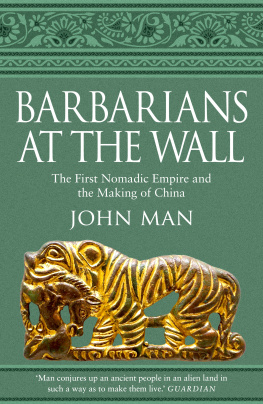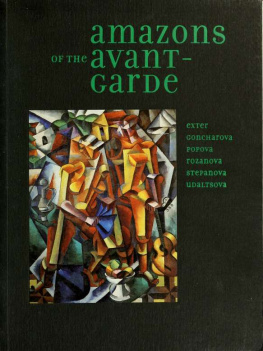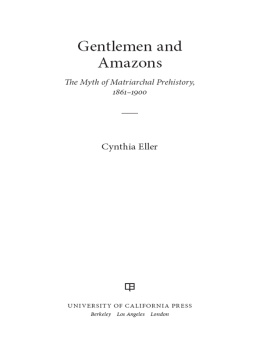Searching for the
AMAZONS
The Real Warrior Women of the Ancient World
JOHN MAN

For T
WHEN I WAS SIX, MY PARENTS TOOK ME TO SEE A STAGE version of Peter Pan in London. I was amazed by Peters ability to fly, a skill he passes on to the Darling children. I asked my mother if she could teach me. She told me to ask Peter. So I wrote to him, c/o whatever theatre it was. To my intense joy, he replied. Revealing a remarkable ability to use a typewriter, he told me that the key was practice. My mother warned that it might take a while. I was up for it, and set about learning to fly by jumping off my parents bed, many times, with my mother assuring me that I had remained aloft just a split second longer each time I jumped. It was hard work, and progress immeasurable. Soon it was time for tea. I dont recall a second flying lesson.
Growing up in an English village, I lacked a ready source of books but read comics, which were already evolving into what would become graphic novels. One of the protagonists was Dan Dare, Pilot of the Future, who was totally convincing to me. Another was Superman, who wasnt. At eight, I had grown older and wiser. I knew from personal experience that flying was impossible. For me, Superman lacked credibility. I simply did not buy into any of his abilities, super-strength, super-vision, all the rest.
I was out of step with popular culture. Superheroes, a term that includes superheroines and supervillains, have remained the mainstays of countless comics, graphic novels and films for fifty years, and show no sign of falling from grace. One website lists 699 of them in alphabetical order from A-Bomb to Zoom. Only one appeals to me: not because shes been around for over seventy years, not because she has recently starred in her own blockbuster, but because of the depth of her back-story. This is Wonder Woman, daughter of Zeus, princess of the Amazons.
In fact, Wonder Woman is even more Amazonian than the Amazons of Greek legend. About 2,750 years ago, the Greeks spun tales about their Amazons as superb women warriors in order to show how terrific men were to defeat them in battle or tumble them into bed. Wonder Woman is not about to be defeated or bedded, even by superheroes. She is equal to, even superior to, any man, super or not. The ancient fable has evolved to suit todays market for superheroes.
But there is now much more to the Amazons than myth.
Aristotle defined man as a political animal, meaning he was most at home in a polis, a city-state like his own Athens. Well, he was wrong in two senses wrong morally, at least from todays perspective, because he ignored Athenss women; and also wrong in the sense of being incorrect. Long before his time, people who were no less human than Greeks had developed an entirely un-polis-like existence on the grasslands of inner Asia, one in which men and women shared a different way of life, without cities or states. The men were both herders and warriors. So were their women.
Thanks to archaeologists, we now know more about them than Aristotle possibly could. Wonder Woman, it turns out, had real ancestral sisters. Right across inner Asia are grave mounds, tens of thousands of them. These tombs were made by Scythians a generalized term for several related cultures who were expert in using the grasslands that run in irregular swathes from Hungary to Mongolia. Most tombs were robbed; but some contained treasures, preserved by cold. Archaeologists have found are finding, will go on finding what the grave-robbers missed: deep-frozen gold, decorations, clothing, bones and bodies. Among them are women whose possessions included weapons and whose remains show signs of violent death: real Amazons, products of a different way of life and a far more sophisticated one than the Greeks dreamed of.
The myth endured, growing new branches down the centuries, influencing art and literature and popular culture, giving the name of Amazon not only to individual warrior women (and countless women fighting for countless causes) but also, more accurately, to very rare groups of women fighters. The myth interacted with the real world: the Amazon rainforest and amazon.com are branches of the same tree. Another branch is Wonder Woman, with her surprisingly radical agenda. In the vision of Wonder Womans creator not Zeus, but William Moulton Marston, in All Star Comics No. 8 in 1941 Amazons were as strong and sexy as in Greek legend, but destined for domination of men not defeat by them. That (he believed) was the way to enduring peace between women and men. Give them an alluring woman stronger than themselves to submit to, he said, and theyll be proud to become her willing slaves! Aristotle would have been appalled.

IMAGINE YOURSELF TO BE A SUITABLY EDUCATED SCHOLAR transported back in time to Athens 2,500 years ago. Its a fine spring day. Wishing to feel in tune with Athenian history, you find yourself climbing the Areopagus, the summit of creamy marble near the Acropolis. You know it as the Hill of Ares, named after the god of war Mars as he would become in Roman times. You are not alone. You come upon an old man in a tunic, resting on a boulder, his head on a stick. You could do with a break. You start a conversation. Hes glad of the company, and something of a historian himself. You ask: was this really the famous rock on which the early city council met? Of course it was, he says. He explains that it has nothing to do with Ares. No one ever worshipped Ares here. Its actually named after arae, curses, because at the bottom of the hill is the cave of the Dread Ones, the Awful Goddesses, the Eumenides, the Furies, who hunted and cursed criminals. The council sat here because it was the key to the city from ancient times, long before the Acropolis. Why, this was the place that stopped the Amazons when they attacked Athens. Oh, you say, you mean the Amazons were real? You thought it was just one tale among many. Of course they were real, these warrior women who lived somewhere to the east, just beyond the edge of the civilized world. Tales passed down the generations from before writing, before the Siege of Troy, before Homer recorded how the heroes of old had actually visited them. The Amazons were as much part of Greek history as the gods.
Ah, you say, so you believe in the gods?
Well, of course, no one has actually seen a god, he explains. At least, not in my time. But the evidence is there in the stories told by our forefathers and in all the shrines and the rituals and sacrifices and oracles and dreams and the way people behave. Do you know what men are like in battle? Have you seen the wildness of a bereaved woman? Theyre possessed! We are all driven by the gods. Thats why we pray to them, and please them with sacrifices. To doubt the gods would be to doubt Greek identity. So of course we believe the gods to be real, and the Amazons too.
We, here and now, in the twenty-first century, have our doubts. Why should anyone take these beliefs seriously? Because they are evidence of a sort doorways to the minds of those who lived in a long-vanished society that is still with us, rooted in our thought, government, art, drama. Perhaps in our minds as well as theirs the gods represent psychological truths about rage, love, jealousy, loyalty and betrayal. Perhaps also the legends hint at historical truths, as Homers great epic of a legendary war points towards the real city of Troy that you can still visit today. Its worth taking a look at the legends. We may learn something about our history and about ourselves.
Next page

















